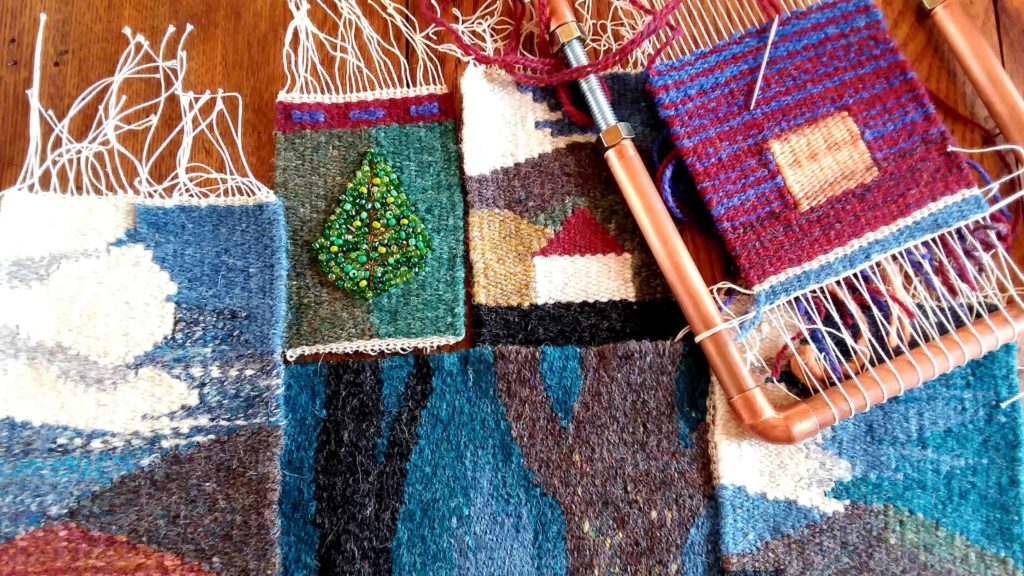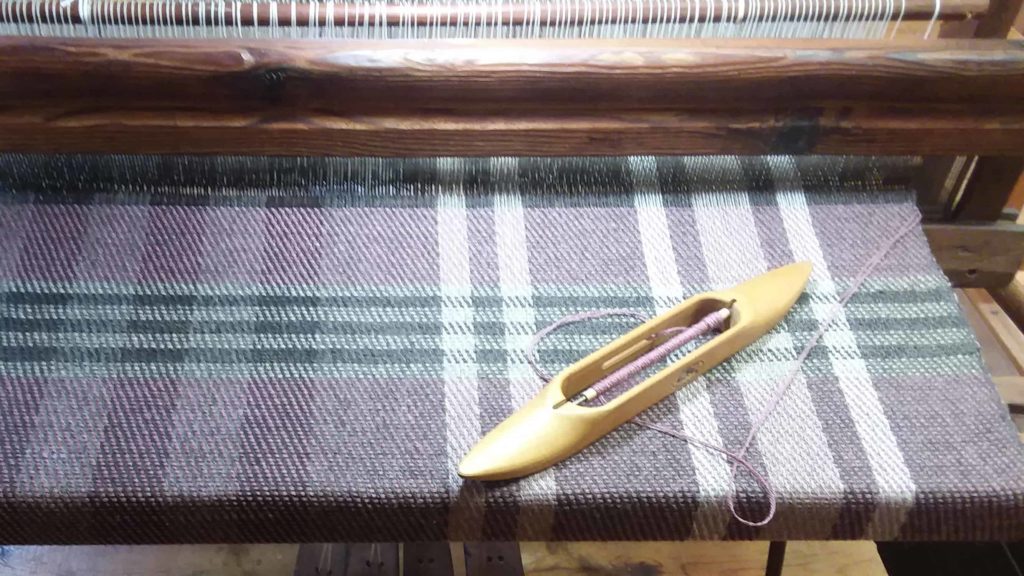The first of the new kids are here, lolloping curiously across clean straw. The farmyard is beginning to stir at the end of winter. On a raw day the Shetland sheep and their Icelandic cousins stand out, with their spiral horns and dark faces. The Jacobs are mottled black and white with double horns, even the ewes. The Cotswolds have long, light, curling wool falling into their eyes. And the Dorsets with their thick straight fleeces are named for the county in England and aptly for a farm on Dorset Mountain in Vermont.
Sculptor, weaver and fiber artist Andrea Myklebust has come a long way to be here, from urban centers and metro lines to a farmyard where she cares for the goats and sheep who grow the wool she will weave by hand.
She and her husband, Stanton Sears, create public art, often influenced by fiber. They are monumental sculptors, and they have often worked with colors and patterns and images inspired by textiles and by the cultural traditions of the place where the art will live.
They have worked with architects and landscape architects, engineers and lighting designers to create these tributes at airports and public buildings. But they come back always to natural shapes.
In one work a bronze disc holds a pattern of maize or the cross-section of an orange. In another, a channel of water reflects a wall of slate. A silvery frame takes the shape of a dragonfly’s wing. A stone at the Minnesota Library for the Blind curves like the spiraling sea snail called a quilted melania.
Fiber art has always had an influence in their work, Myklebust said. Woven forms and techniques have often shaped their monumental sculpture. They have created more than 70 public works across the country — in the Midwest, California, Florida, Alaska. They hold the feel of cloth in stone and steel.
And now they are involved with it from the day the kids are born.

Andrea Myklebust weaves and teaches her art at Mountain Heart Farm in Danby, Vt. Press courtesy photo
They began that transition two years ago, long before they could imagine weathering a pandemic on a mountain farm. They moved from western Wisconsin to southern Vermont two years go, after Sears retired as an art professor from Macalester College in Saint Paul, Minnesota. They have come here to a part of the country with a long tradition of blending art and craft and a growing community of farmers and fiber artists. The area has a history of textile mills and a far longer one of weaving in many forms.
Myklebust is seeing a growing interest, she said, especially in a cold season when people are quarantining at home. She has met local artists and artisans making a living at the craft and local people who like working with their hands — or want a brilliantly colorful pair of socks and like the idea of knowing where they came from.
This winter and spring, she will teach virtual workshops with the her own the new Mountain Heart School of Craft and with the Southern Vermont Arts Center.
Myklebust and her husband are restoring an old farmhouse in Danby, leading classes in art and craft and building a farm shop for handspun yarns, wool, flax, handknit and handwoven cloth … and a studio space for their own work.
‘The draw loom is like a piano keyboard. You can let the pattern ebb and flow, emerge and dissipate … and you can play with it.’
Fiber echoes in their solo work, she said, as it does in their large outdoor innovations. Her husband carves interlaced forms in wood like the fibers in a skein of yarn. She spins and weaves the wool from their flock of 25 sheep.
While they prepare space in their new home, she has rented space in Danby village, she said, in an old building downtown. She weaves scarves, towels and textiles on three floor looms, one an antique from the 1870s, the kind many Scandinavian immigrants used.
The largest is a draw loom, with controls for detailed pictoral work, and working with it can be improvisational.
“Weaving is usally controlled,” she said — “you have to plan ahead, and you know everything about the cloth you will make before you begin. The draw loom is like a piano keyboard. You can let the pattern ebb and flow, emerge and dissipate … and you can play with it.”
Weaving from the roots
For people who are curious to try a new skill, Myklebust will lead classes this winter and spring.
In late January and February, she led a group into twined weaving. It is an ancient technique, she said. Every culture on earth has a form of it. Looms have a mechanism to raise and lower groups of warp threads — but here the warp threads, the longwise threads, keep still, and the weaver moves the weft threads, the crosswise threads, around them by hand.
She has seen many kinds, from the Maori to Scandinavia, all of them beautiful — skirts and dancing robes, baskets and blankets. The Tlingit in the Pacific Northwest have their own vividly bright Chilkat weaving patterns, she said. In Somalia, women weave bags and containers and even the walls of portable shelters, and they brighten the walls with woven scenes.
Twined weaving can be easy to carry, Myklebust said. She works on a wooden frame loom that she can hold in her lap. And twining lends itself to teaching virtually in this odd time.
She and her students can work with different materials, cotton and hemp and wool. In this class they will use threads made in Vermont, from Three Loose Ladies yarn shop in Chester, Vt., They can adapt the color and pattern and improvise in a way she rarely can when she is weaving on a loom.
“It takes time,” she said. “That can be an appeal in a pandemic winter. What’s your hurry? It’s meditative.”

Andrea Myklebust weaves textiles from natural fibers. Press courtesy photo
Finding calm in natural rhythms
She feels its lure especially now, in an anxious time, and she sees other people finding comfort in it too. In Covid, as local shops and craft festivals have paused or closed, teaching has remained most steady for her.
She taught her first online classes last May, she said. Teaching virtually is different in many ways from working with a group of people together, when she can walk through the room and see their work, when she can talk with them, and they can talk together.
“I have so much sympathy and empathy for teachers and students,” she said. “And I don’t have to evaluate anyone. People are here because they want to be here, and I don’t have to give anyone a grade. If they feel they’ve learned something, then we’re good.”
But teaching virtually has its own power, and in a time of enforced isolation she finds communion in it as much as she hopes her students will.
“I was wrapping up a flax to linen class,” she said, “and I realized I was stalling because I didn’t want to say goodbye. It’s a difficult world, teaching art, but you make genuine connections to people.”
Later in the season she will teach spinning on a hand spindle and tapestry weaving. She also does some dye-work, she said, and in the past two or three years she has been exploring natural dyes and partnering with Smokey House Center in Danby, Vt., to lead natural dye workshops.
Her daughter, Tansy Sears, has led her in this exploration. They harvest dye plants from the land around them — black walnuts, daylilies, marigolds, goldenrod. From buckthorn, an invasive woody plant, they can bark, berries, and leaves. Her daughter has done longer-term dye work with lichens too, Myklebust said. They give a bright pink-purple dye.
“It’s very slow process,” she said. “You have to steep the wool or fabric in the dye for months.”
They also grow classic European dye plants in their garden, plants like woad and madder.
“You have a different appreciation for color,” she said, “when you have to harvest it.”

